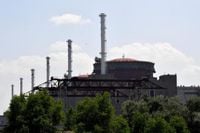Ukrainian President Volodymyr Zelenskyy has sounded an urgent alarm over the safety of his country’s nuclear facilities, following a dramatic escalation in Russian drone attacks that have targeted critical energy infrastructure. On October 1, 2025, more than 20 Iranian-made Shahed drones launched by Russia struck the northern city of Slavutych, the lifeline for Chernobyl’s power supply, plunging the area into darkness for over three hours. The blackout directly affected the sarcophagus encasing the destroyed fourth reactor at Chernobyl—the scene of the world’s worst nuclear disaster in 1986—and storage facilities housing more than 3,000 tons of spent nuclear fuel, according to the Associated Press and multiple official statements from Kyiv.
The timing of the attack couldn’t have been more ominous. Both the Chernobyl site and the Russian-occupied Zaporizhzhia Nuclear Power Plant—Europe’s largest and among the ten biggest worldwide—are currently not operational. Yet, these facilities still require a constant and stable power supply to run crucial cooling systems for spent fuel rods. Without this, the risk of a nuclear incident rises sharply. “Russia is deliberately creating the threat of radiation incidents,” President Zelenskyy declared in a late-night video address, sharply criticizing what he described as “weak responses” from the United Nations’ nuclear watchdog, the International Atomic Energy Agency (IAEA), and its chief, Rafael Mariano Grossi. “Every day of Russia’s war, every strike on our energy facilities, including those connected to nuclear safety, is a global threat,” Zelenskyy said. “Weak and half-measures will not work. Strong action is needed.”
The power outage in Slavutych wasn’t just a local inconvenience. According to Ukrainian officials, it disabled radiation monitoring systems operated by the IAEA at Chernobyl, blinding a key security safeguard. Zelenskyy underlined the gravity of the situation: “The Russians could not have been unaware that a strike on Slavutych would have such consequences for Chernobyl.” The president’s comments echo deepening anxieties across the region, with the AP and other outlets noting that a previous drone strike in February 2025 had already tested the site’s resilience—then, a drone armed with a warhead struck Chernobyl’s protective outer shell, briefly starting a fire but, fortunately, not raising radiation levels.
Meanwhile, the Zaporizhzhia nuclear plant—under Russian occupation and a repeated flashpoint in the ongoing war—has been disconnected from Ukraine’s power grid for over a week as of October 3, 2025. The plant is now relying on emergency diesel generators to keep its six inactive reactors and spent fuel pools cool. Ukraine’s Energy Ministry has described the situation as unprecedented, stating, “No nuclear power plant in the world has ever operated under such conditions, and it is impossible to make any reliable forecasts.” The IAEA has sought to reassure the public, saying the plant is not in immediate danger, but has called for its swift reconnection to the grid to avoid further risk.
The blame game over who is responsible for these dangerous conditions has become a new front in the conflict. President Zelenskyy has pointed the finger at Russian artillery for damaging power lines to the Zaporizhzhia plant, while Russian President Vladimir Putin has dismissed the accusations as “nonsense,” instead accusing Ukraine of shelling the Moscow-controlled facility. Putin warned, “People on the other side must understand that if they continue this dangerous game, they also have functioning nuclear power plants. What would prevent us from responding in kind? Let them think about it.”
Experts are deeply concerned. Edwin Lyman, director of nuclear power safety at the Union of Concerned Scientists, told the AP that “no nuclear plant was designed to be able to function safely for an extended period without access to stable off-site power.” He described the situation at Zaporizhzhia as “extremely fragile and increasingly dire,” noting that a disruption in cooling could result in the release of significant radioactive material within several days or longer. The U.S.-based Institute for the Study of War has also weighed in, arguing that Russia’s occupation of Zaporizhzhia has “significantly degraded” the plant’s safety and warning that Moscow appears intent on integrating the facility into its own grid—a move that would not only exacerbate security risks but also undermine Ukraine’s future energy capacity.
The broader context is equally troubling. The war, which erupted after Russia’s full-scale invasion of Ukraine more than three years ago, shows little sign of abating despite months of U.S.-led peace efforts. Both sides have escalated their rhetoric and actions, with nuclear safety now a central concern for international observers. As the AP and other sources have reported, a prolonged loss of power to cooling systems at either Chernobyl or Zaporizhzhia could disable radiation monitoring and potentially lead to catastrophic radioactive releases.
Amid these nuclear anxieties, there was at least one rare moment of cooperation. On October 2, 2025, Russia and Ukraine exchanged hundreds of prisoners of war in a swap brokered in Istanbul. President Zelenskyy announced that 185 Ukrainian military personnel—many held captive since 2022—and 20 civilians were returned home. Russia’s Defense Ministry confirmed that 185 of its soldiers and 20 civilians were handed back by Ukraine. The returnees were initially received in Belarus for medical and psychological care before being transferred to Russia for further rehabilitation. Since the start of the war, more than 7,000 Ukrainians have been repatriated, according to Zelenskyy’s Telegram channel.
This exchange followed earlier agreements reached in Türkiye during the summer, which included arrangements for the repatriation of frozen remains, the release of severely wounded soldiers, and swaps of prisoners under the age of 25. While these humanitarian gestures offer a glimmer of hope, they do little to offset the mounting risks posed by the weaponization of Ukraine’s energy infrastructure and the specter of a nuclear incident.
As the war drags on, the international community faces a stark dilemma. The IAEA continues to urge all parties to safeguard nuclear sites, but the repeated targeting of energy facilities has made the situation more volatile than ever. With both sides blaming each other for attacks on Zaporizhzhia and Chernobyl’s power supplies, and with technical experts warning of unprecedented dangers, Ukraine’s nuclear plants remain at the heart of a geopolitical storm. The world, it seems, is left holding its breath, hoping that the next blackout does not trigger a disaster with consequences far beyond the battlefield.




